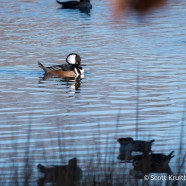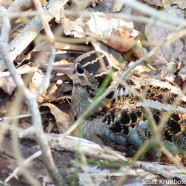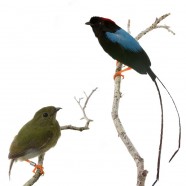Hooded Mergansers
It has been a great autumn for Hooded Mergansers (Lophodytes cucullatus) even as we near the end of the season, with all of the above-average temperatures, little ice and rarely seen snow. Courting is well underway for these birds as you can see by the striking black-and-white crests being displayed by the drakes. The several hens present on this pond were mostly preoccupied with trying to take a nap or grabbing a bite to eat. The boys kept swimming after them, vocalizing and trying their best to get some attention. When it comes time to breed these birds will be making their nests in tree...
Read MoreRed Fox (Vulpes vulpes)
This Red Fox (Vulpes vulpes) is a “vixen” (female), and the only reason I know that is because she is a dear old friend. The Red Fox pair who breed on the Stratford Point property are well known to us, and we are well known to them. The male, usually called a “dog”, has a scar on his face and a damaged eye. They are intelligent and inquisitive creatures, and they do learn a little about who is around them frequently and whether or not they are a threat. In this case she was very sleepy and sunning as she snoozed, making her all the more relaxed around me in her drowsy...
Read MoreCaspian Tern Courtship
Here is a terrific capture of Caspian Terns engaged in courtship feeding, as taken at Wright Park Beach in Dunkirk, New York by our friend Gale VerHague. Please join us tomorrow, Wednesday, April 29, 2015 at RTPI at 7:00PM to hear Gale while she displays more of her tremendous photography – “Chasing Feathers: Birding with a Camera in Western New York and Beyond”. Gale will be showing a series of shots of this very event which is what sparked her birding blog in 2009. This is a free and public evening at RTPI, and we hope to see you then!
Read MoreHidden American Woodcocks
March is the month for the American Woodcock (Scolopax minor) as the species heads north to (hopefully) unfrozen earth, with males arriving as quickly as they can to set up on the best territory for their legendary display flights. This year’s polar lock on the region may slow them down as feeding will be very difficult, if not impossible, for another week or two at least. Open fields and meadows adjacent to wetlands, marshes and scrubby/shrubby lands are good places to wait for their evening aerial dances later in the month. I photographed these two birds in the early winter, long...
Read MoreLong-tailed Manakin (Chiroxiphia linearis) Pair
We have showed you the exquisite male previously but here we have both the Long-tailed Manakin (Chiroxiphia linearis) male and a lovely female by RTPI Affiliate Sean Graesser. He notes that you can see the interesting sexual dimorphism Manakins have. Most species congregate in a lek, where the males perform a dance for the female, after which she makes the nest and raises the chicks. Photographed for the Meet Your Neighbours global biodiversity project in Costa Rica.
Read More








